Corporate Law Assignment: Constitution, Amendments, and Rights
VerifiedAdded on 2023/06/07
|10
|2850
|141
Report
AI Summary
This report delves into the core principles of corporate law, specifically focusing on the governing documents of companies registered under the Corporations Act 2001. It explores the purpose of a company's constitution, its role in regulating internal management, and the process of amendment. The report examines the requirements for amending a company's constitution, including special resolutions and the need for fairness, and evaluates whether these requirements adequately protect minority shareholders. Furthermore, the report analyzes the limits on the power of majority shareholders regarding the variation of member rights, referencing relevant Australian case law and legislation to illustrate key concepts such as expropriation of shares and the protection of minority interests. The document highlights key cases like Allen v. Gold Reefs of West Africa Ltd, Crumpton v. Morrine Hall Pty Ltd, Sidebottom v. Kershaw, and Brown v. British Abrasive Wheel Co Ltd, to provide a comprehensive understanding of the legal framework surrounding company constitutions and shareholder rights.
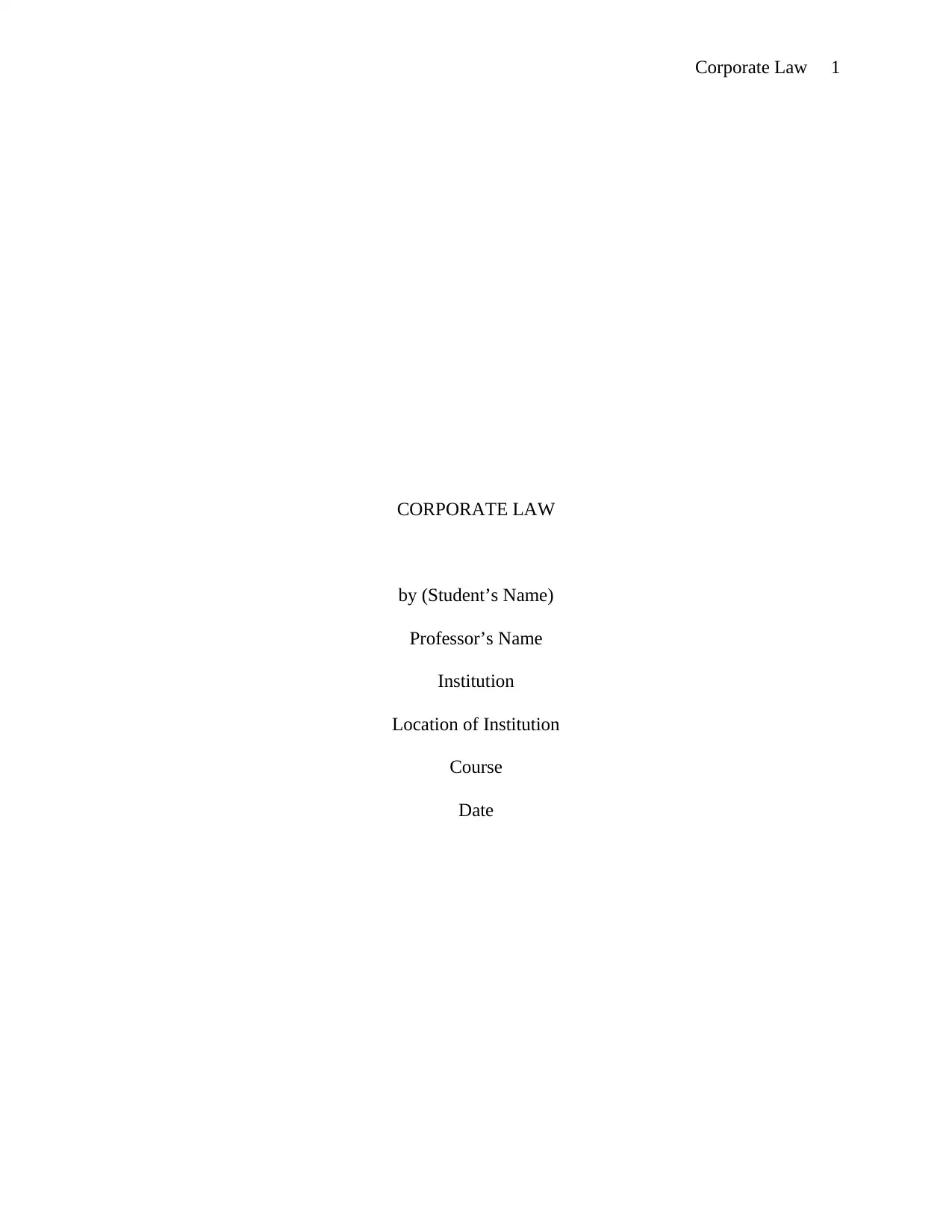
Corporate Law 1
CORPORATE LAW
by (Student’s Name)
Professor’s Name
Institution
Location of Institution
Course
Date
CORPORATE LAW
by (Student’s Name)
Professor’s Name
Institution
Location of Institution
Course
Date
Paraphrase This Document
Need a fresh take? Get an instant paraphrase of this document with our AI Paraphraser
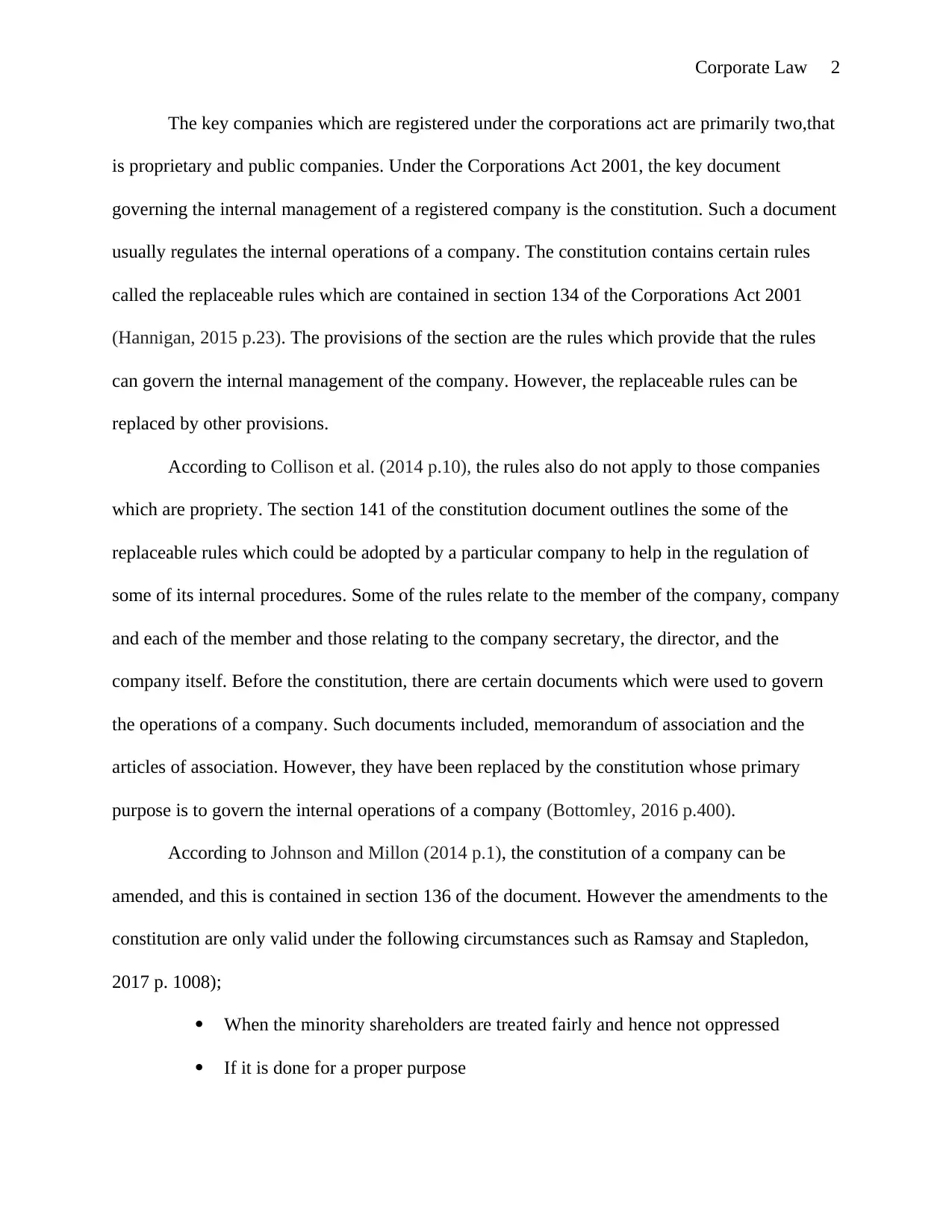
Corporate Law 2
The key companies which are registered under the corporations act are primarily two,that
is proprietary and public companies. Under the Corporations Act 2001, the key document
governing the internal management of a registered company is the constitution. Such a document
usually regulates the internal operations of a company. The constitution contains certain rules
called the replaceable rules which are contained in section 134 of the Corporations Act 2001
(Hannigan, 2015 p.23). The provisions of the section are the rules which provide that the rules
can govern the internal management of the company. However, the replaceable rules can be
replaced by other provisions.
According to Collison et al. (2014 p.10), the rules also do not apply to those companies
which are propriety. The section 141 of the constitution document outlines the some of the
replaceable rules which could be adopted by a particular company to help in the regulation of
some of its internal procedures. Some of the rules relate to the member of the company, company
and each of the member and those relating to the company secretary, the director, and the
company itself. Before the constitution, there are certain documents which were used to govern
the operations of a company. Such documents included, memorandum of association and the
articles of association. However, they have been replaced by the constitution whose primary
purpose is to govern the internal operations of a company (Bottomley, 2016 p.400).
According to Johnson and Millon (2014 p.1), the constitution of a company can be
amended, and this is contained in section 136 of the document. However the amendments to the
constitution are only valid under the following circumstances such as Ramsay and Stapledon,
2017 p. 1008);
When the minority shareholders are treated fairly and hence not oppressed
If it is done for a proper purpose
The key companies which are registered under the corporations act are primarily two,that
is proprietary and public companies. Under the Corporations Act 2001, the key document
governing the internal management of a registered company is the constitution. Such a document
usually regulates the internal operations of a company. The constitution contains certain rules
called the replaceable rules which are contained in section 134 of the Corporations Act 2001
(Hannigan, 2015 p.23). The provisions of the section are the rules which provide that the rules
can govern the internal management of the company. However, the replaceable rules can be
replaced by other provisions.
According to Collison et al. (2014 p.10), the rules also do not apply to those companies
which are propriety. The section 141 of the constitution document outlines the some of the
replaceable rules which could be adopted by a particular company to help in the regulation of
some of its internal procedures. Some of the rules relate to the member of the company, company
and each of the member and those relating to the company secretary, the director, and the
company itself. Before the constitution, there are certain documents which were used to govern
the operations of a company. Such documents included, memorandum of association and the
articles of association. However, they have been replaced by the constitution whose primary
purpose is to govern the internal operations of a company (Bottomley, 2016 p.400).
According to Johnson and Millon (2014 p.1), the constitution of a company can be
amended, and this is contained in section 136 of the document. However the amendments to the
constitution are only valid under the following circumstances such as Ramsay and Stapledon,
2017 p. 1008);
When the minority shareholders are treated fairly and hence not oppressed
If it is done for a proper purpose
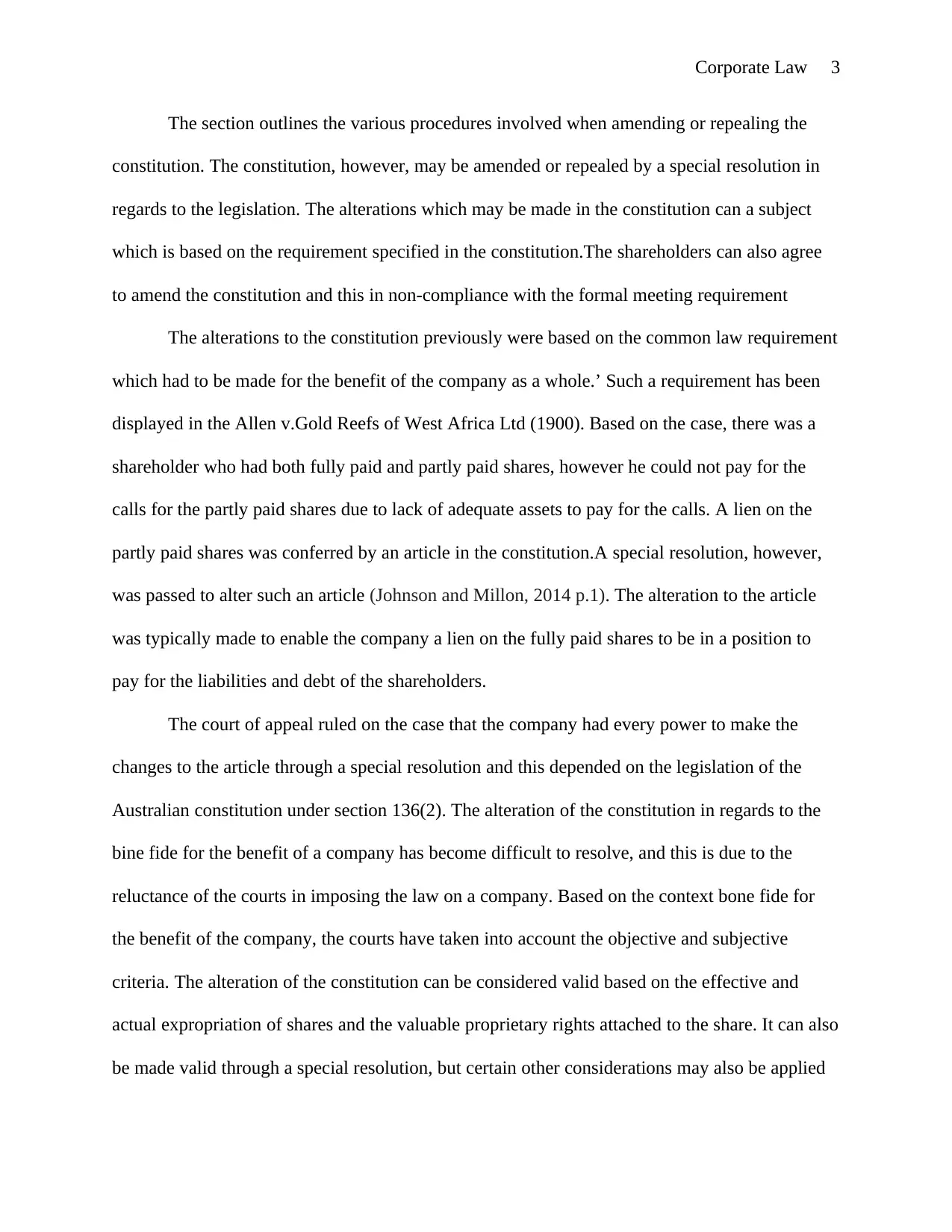
Corporate Law 3
The section outlines the various procedures involved when amending or repealing the
constitution. The constitution, however, may be amended or repealed by a special resolution in
regards to the legislation. The alterations which may be made in the constitution can a subject
which is based on the requirement specified in the constitution.The shareholders can also agree
to amend the constitution and this in non-compliance with the formal meeting requirement
The alterations to the constitution previously were based on the common law requirement
which had to be made for the benefit of the company as a whole.’ Such a requirement has been
displayed in the Allen v.Gold Reefs of West Africa Ltd (1900). Based on the case, there was a
shareholder who had both fully paid and partly paid shares, however he could not pay for the
calls for the partly paid shares due to lack of adequate assets to pay for the calls. A lien on the
partly paid shares was conferred by an article in the constitution.A special resolution, however,
was passed to alter such an article (Johnson and Millon, 2014 p.1). The alteration to the article
was typically made to enable the company a lien on the fully paid shares to be in a position to
pay for the liabilities and debt of the shareholders.
The court of appeal ruled on the case that the company had every power to make the
changes to the article through a special resolution and this depended on the legislation of the
Australian constitution under section 136(2). The alteration of the constitution in regards to the
bine fide for the benefit of a company has become difficult to resolve, and this is due to the
reluctance of the courts in imposing the law on a company. Based on the context bone fide for
the benefit of the company, the courts have taken into account the objective and subjective
criteria. The alteration of the constitution can be considered valid based on the effective and
actual expropriation of shares and the valuable proprietary rights attached to the share. It can also
be made valid through a special resolution, but certain other considerations may also be applied
The section outlines the various procedures involved when amending or repealing the
constitution. The constitution, however, may be amended or repealed by a special resolution in
regards to the legislation. The alterations which may be made in the constitution can a subject
which is based on the requirement specified in the constitution.The shareholders can also agree
to amend the constitution and this in non-compliance with the formal meeting requirement
The alterations to the constitution previously were based on the common law requirement
which had to be made for the benefit of the company as a whole.’ Such a requirement has been
displayed in the Allen v.Gold Reefs of West Africa Ltd (1900). Based on the case, there was a
shareholder who had both fully paid and partly paid shares, however he could not pay for the
calls for the partly paid shares due to lack of adequate assets to pay for the calls. A lien on the
partly paid shares was conferred by an article in the constitution.A special resolution, however,
was passed to alter such an article (Johnson and Millon, 2014 p.1). The alteration to the article
was typically made to enable the company a lien on the fully paid shares to be in a position to
pay for the liabilities and debt of the shareholders.
The court of appeal ruled on the case that the company had every power to make the
changes to the article through a special resolution and this depended on the legislation of the
Australian constitution under section 136(2). The alteration of the constitution in regards to the
bine fide for the benefit of a company has become difficult to resolve, and this is due to the
reluctance of the courts in imposing the law on a company. Based on the context bone fide for
the benefit of the company, the courts have taken into account the objective and subjective
criteria. The alteration of the constitution can be considered valid based on the effective and
actual expropriation of shares and the valuable proprietary rights attached to the share. It can also
be made valid through a special resolution, but certain other considerations may also be applied
⊘ This is a preview!⊘
Do you want full access?
Subscribe today to unlock all pages.

Trusted by 1+ million students worldwide
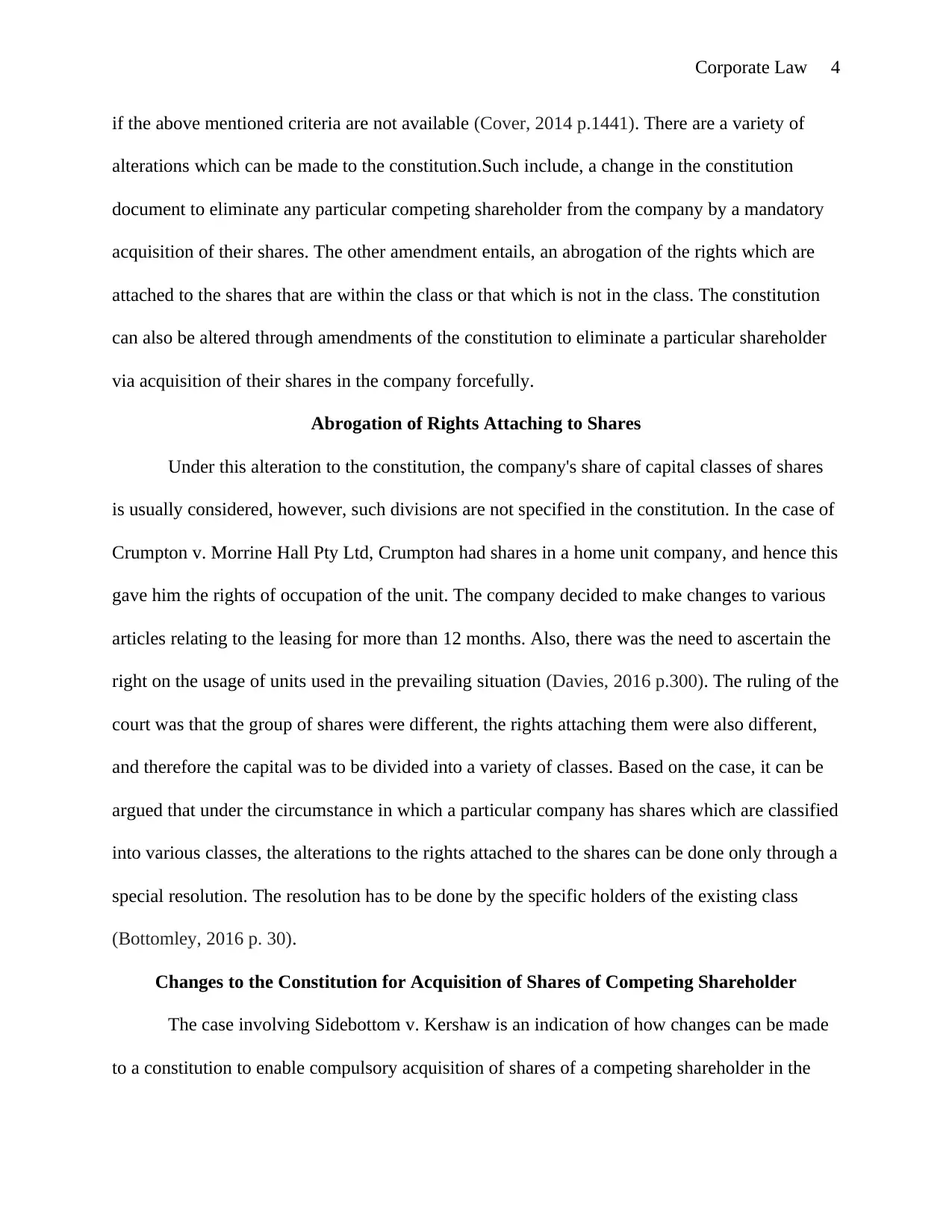
Corporate Law 4
if the above mentioned criteria are not available (Cover, 2014 p.1441). There are a variety of
alterations which can be made to the constitution.Such include, a change in the constitution
document to eliminate any particular competing shareholder from the company by a mandatory
acquisition of their shares. The other amendment entails, an abrogation of the rights which are
attached to the shares that are within the class or that which is not in the class. The constitution
can also be altered through amendments of the constitution to eliminate a particular shareholder
via acquisition of their shares in the company forcefully.
Abrogation of Rights Attaching to Shares
Under this alteration to the constitution, the company's share of capital classes of shares
is usually considered, however, such divisions are not specified in the constitution. In the case of
Crumpton v. Morrine Hall Pty Ltd, Crumpton had shares in a home unit company, and hence this
gave him the rights of occupation of the unit. The company decided to make changes to various
articles relating to the leasing for more than 12 months. Also, there was the need to ascertain the
right on the usage of units used in the prevailing situation (Davies, 2016 p.300). The ruling of the
court was that the group of shares were different, the rights attaching them were also different,
and therefore the capital was to be divided into a variety of classes. Based on the case, it can be
argued that under the circumstance in which a particular company has shares which are classified
into various classes, the alterations to the rights attached to the shares can be done only through a
special resolution. The resolution has to be done by the specific holders of the existing class
(Bottomley, 2016 p. 30).
Changes to the Constitution for Acquisition of Shares of Competing Shareholder
The case involving Sidebottom v. Kershaw is an indication of how changes can be made
to a constitution to enable compulsory acquisition of shares of a competing shareholder in the
if the above mentioned criteria are not available (Cover, 2014 p.1441). There are a variety of
alterations which can be made to the constitution.Such include, a change in the constitution
document to eliminate any particular competing shareholder from the company by a mandatory
acquisition of their shares. The other amendment entails, an abrogation of the rights which are
attached to the shares that are within the class or that which is not in the class. The constitution
can also be altered through amendments of the constitution to eliminate a particular shareholder
via acquisition of their shares in the company forcefully.
Abrogation of Rights Attaching to Shares
Under this alteration to the constitution, the company's share of capital classes of shares
is usually considered, however, such divisions are not specified in the constitution. In the case of
Crumpton v. Morrine Hall Pty Ltd, Crumpton had shares in a home unit company, and hence this
gave him the rights of occupation of the unit. The company decided to make changes to various
articles relating to the leasing for more than 12 months. Also, there was the need to ascertain the
right on the usage of units used in the prevailing situation (Davies, 2016 p.300). The ruling of the
court was that the group of shares were different, the rights attaching them were also different,
and therefore the capital was to be divided into a variety of classes. Based on the case, it can be
argued that under the circumstance in which a particular company has shares which are classified
into various classes, the alterations to the rights attached to the shares can be done only through a
special resolution. The resolution has to be done by the specific holders of the existing class
(Bottomley, 2016 p. 30).
Changes to the Constitution for Acquisition of Shares of Competing Shareholder
The case involving Sidebottom v. Kershaw is an indication of how changes can be made
to a constitution to enable compulsory acquisition of shares of a competing shareholder in the
Paraphrase This Document
Need a fresh take? Get an instant paraphrase of this document with our AI Paraphraser
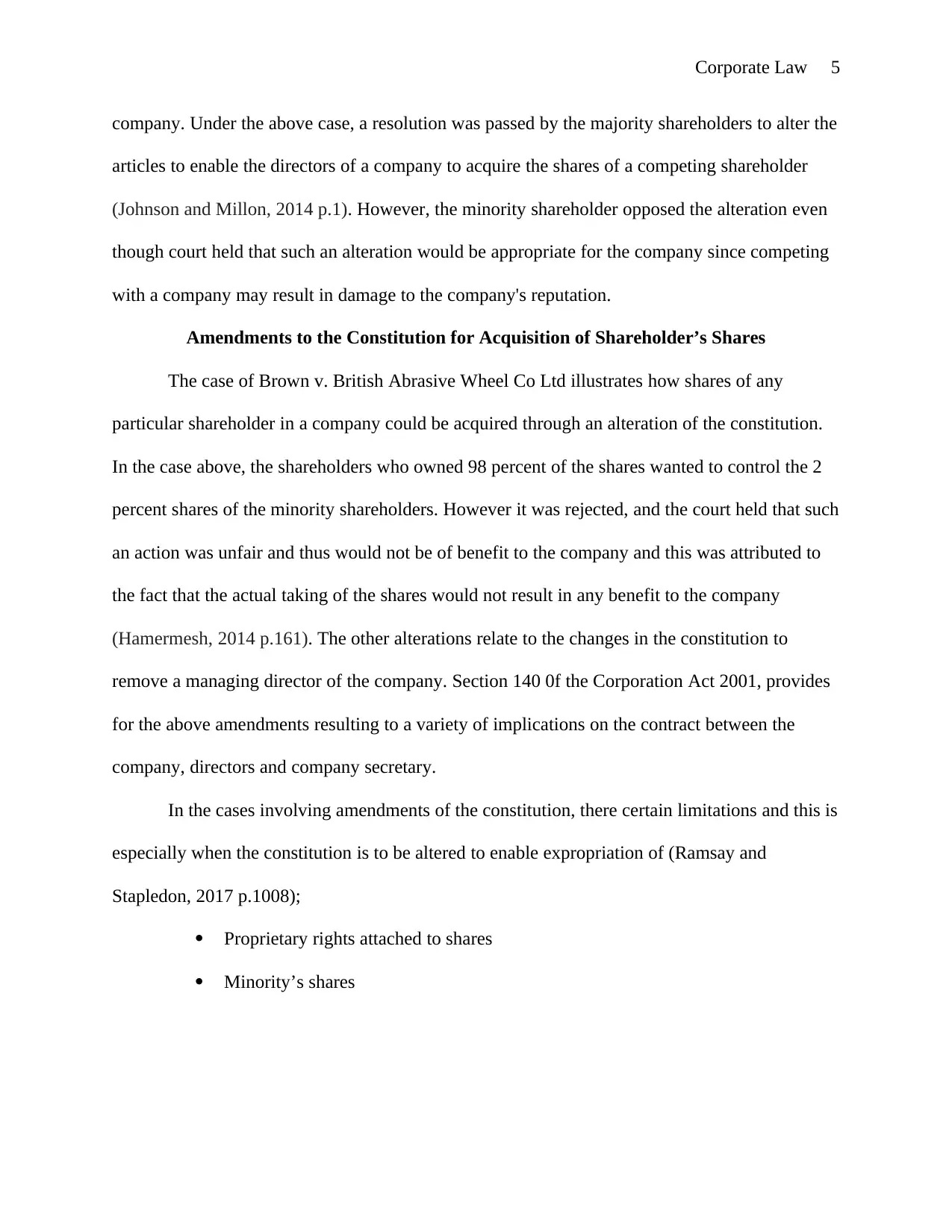
Corporate Law 5
company. Under the above case, a resolution was passed by the majority shareholders to alter the
articles to enable the directors of a company to acquire the shares of a competing shareholder
(Johnson and Millon, 2014 p.1). However, the minority shareholder opposed the alteration even
though court held that such an alteration would be appropriate for the company since competing
with a company may result in damage to the company's reputation.
Amendments to the Constitution for Acquisition of Shareholder’s Shares
The case of Brown v. British Abrasive Wheel Co Ltd illustrates how shares of any
particular shareholder in a company could be acquired through an alteration of the constitution.
In the case above, the shareholders who owned 98 percent of the shares wanted to control the 2
percent shares of the minority shareholders. However it was rejected, and the court held that such
an action was unfair and thus would not be of benefit to the company and this was attributed to
the fact that the actual taking of the shares would not result in any benefit to the company
(Hamermesh, 2014 p.161). The other alterations relate to the changes in the constitution to
remove a managing director of the company. Section 140 0f the Corporation Act 2001, provides
for the above amendments resulting to a variety of implications on the contract between the
company, directors and company secretary.
In the cases involving amendments of the constitution, there certain limitations and this is
especially when the constitution is to be altered to enable expropriation of (Ramsay and
Stapledon, 2017 p.1008);
Proprietary rights attached to shares
Minority’s shares
company. Under the above case, a resolution was passed by the majority shareholders to alter the
articles to enable the directors of a company to acquire the shares of a competing shareholder
(Johnson and Millon, 2014 p.1). However, the minority shareholder opposed the alteration even
though court held that such an alteration would be appropriate for the company since competing
with a company may result in damage to the company's reputation.
Amendments to the Constitution for Acquisition of Shareholder’s Shares
The case of Brown v. British Abrasive Wheel Co Ltd illustrates how shares of any
particular shareholder in a company could be acquired through an alteration of the constitution.
In the case above, the shareholders who owned 98 percent of the shares wanted to control the 2
percent shares of the minority shareholders. However it was rejected, and the court held that such
an action was unfair and thus would not be of benefit to the company and this was attributed to
the fact that the actual taking of the shares would not result in any benefit to the company
(Hamermesh, 2014 p.161). The other alterations relate to the changes in the constitution to
remove a managing director of the company. Section 140 0f the Corporation Act 2001, provides
for the above amendments resulting to a variety of implications on the contract between the
company, directors and company secretary.
In the cases involving amendments of the constitution, there certain limitations and this is
especially when the constitution is to be altered to enable expropriation of (Ramsay and
Stapledon, 2017 p.1008);
Proprietary rights attached to shares
Minority’s shares
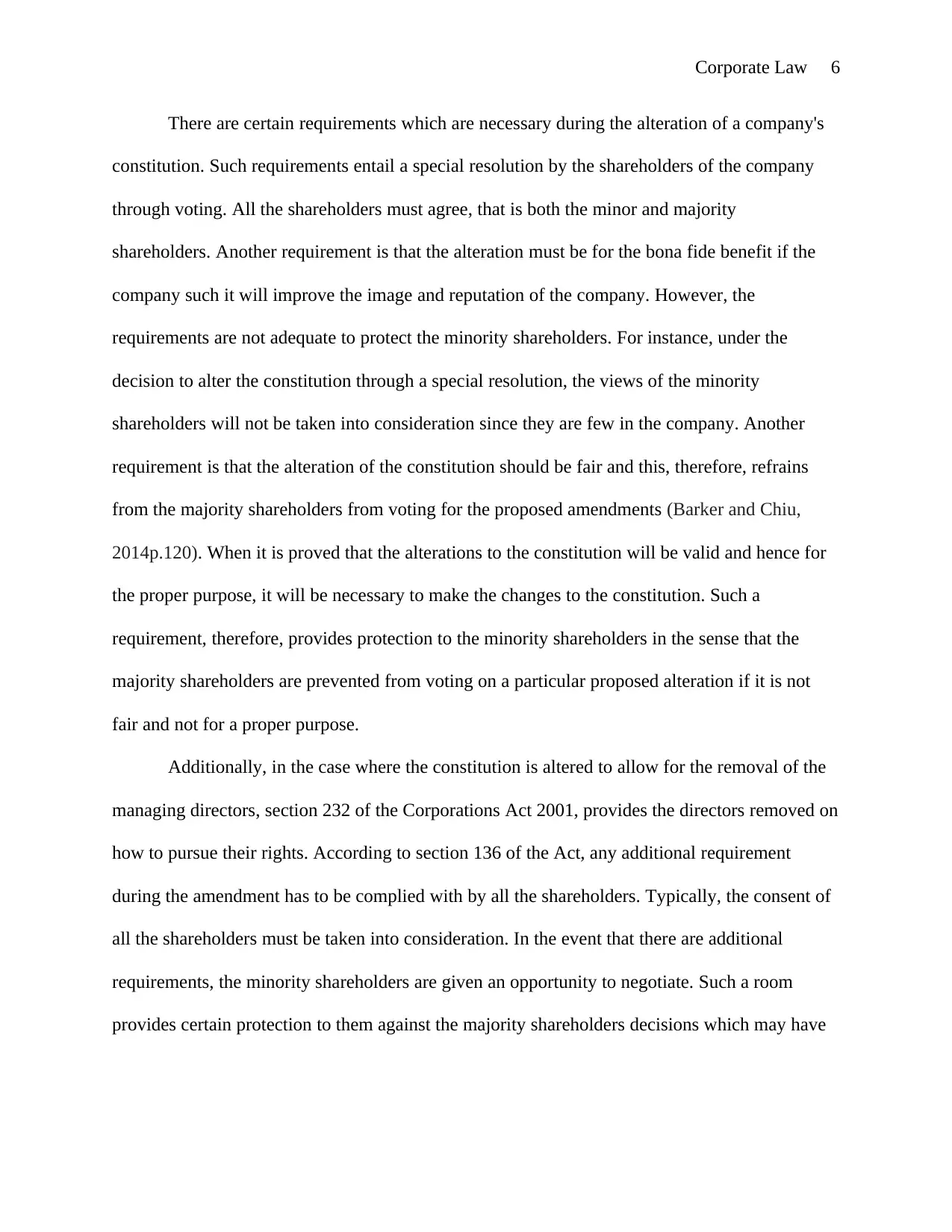
Corporate Law 6
There are certain requirements which are necessary during the alteration of a company's
constitution. Such requirements entail a special resolution by the shareholders of the company
through voting. All the shareholders must agree, that is both the minor and majority
shareholders. Another requirement is that the alteration must be for the bona fide benefit if the
company such it will improve the image and reputation of the company. However, the
requirements are not adequate to protect the minority shareholders. For instance, under the
decision to alter the constitution through a special resolution, the views of the minority
shareholders will not be taken into consideration since they are few in the company. Another
requirement is that the alteration of the constitution should be fair and this, therefore, refrains
from the majority shareholders from voting for the proposed amendments (Barker and Chiu,
2014p.120). When it is proved that the alterations to the constitution will be valid and hence for
the proper purpose, it will be necessary to make the changes to the constitution. Such a
requirement, therefore, provides protection to the minority shareholders in the sense that the
majority shareholders are prevented from voting on a particular proposed alteration if it is not
fair and not for a proper purpose.
Additionally, in the case where the constitution is altered to allow for the removal of the
managing directors, section 232 of the Corporations Act 2001, provides the directors removed on
how to pursue their rights. According to section 136 of the Act, any additional requirement
during the amendment has to be complied with by all the shareholders. Typically, the consent of
all the shareholders must be taken into consideration. In the event that there are additional
requirements, the minority shareholders are given an opportunity to negotiate. Such a room
provides certain protection to them against the majority shareholders decisions which may have
There are certain requirements which are necessary during the alteration of a company's
constitution. Such requirements entail a special resolution by the shareholders of the company
through voting. All the shareholders must agree, that is both the minor and majority
shareholders. Another requirement is that the alteration must be for the bona fide benefit if the
company such it will improve the image and reputation of the company. However, the
requirements are not adequate to protect the minority shareholders. For instance, under the
decision to alter the constitution through a special resolution, the views of the minority
shareholders will not be taken into consideration since they are few in the company. Another
requirement is that the alteration of the constitution should be fair and this, therefore, refrains
from the majority shareholders from voting for the proposed amendments (Barker and Chiu,
2014p.120). When it is proved that the alterations to the constitution will be valid and hence for
the proper purpose, it will be necessary to make the changes to the constitution. Such a
requirement, therefore, provides protection to the minority shareholders in the sense that the
majority shareholders are prevented from voting on a particular proposed alteration if it is not
fair and not for a proper purpose.
Additionally, in the case where the constitution is altered to allow for the removal of the
managing directors, section 232 of the Corporations Act 2001, provides the directors removed on
how to pursue their rights. According to section 136 of the Act, any additional requirement
during the amendment has to be complied with by all the shareholders. Typically, the consent of
all the shareholders must be taken into consideration. In the event that there are additional
requirements, the minority shareholders are given an opportunity to negotiate. Such a room
provides certain protection to them against the majority shareholders decisions which may have
⊘ This is a preview!⊘
Do you want full access?
Subscribe today to unlock all pages.

Trusted by 1+ million students worldwide
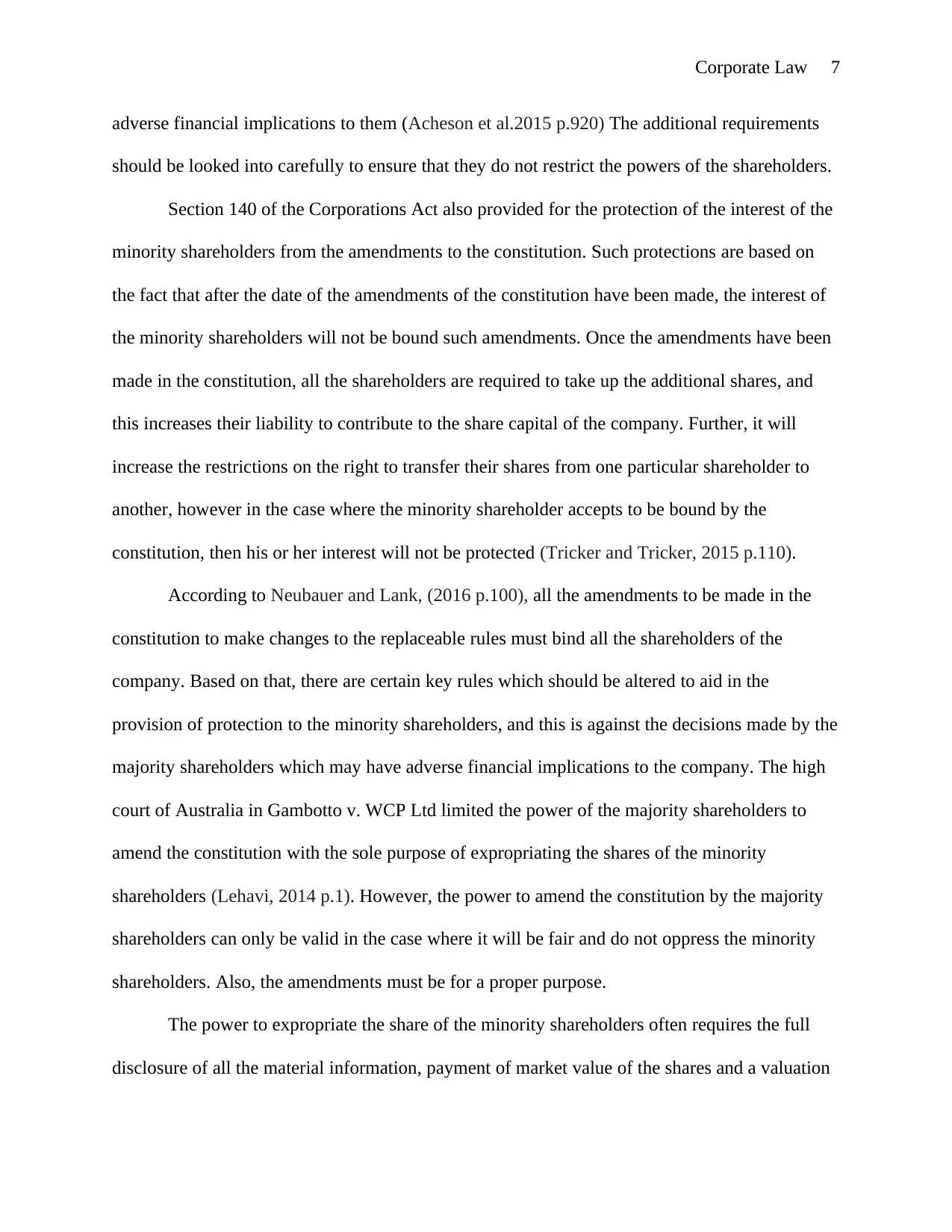
Corporate Law 7
adverse financial implications to them (Acheson et al.2015 p.920) The additional requirements
should be looked into carefully to ensure that they do not restrict the powers of the shareholders.
Section 140 of the Corporations Act also provided for the protection of the interest of the
minority shareholders from the amendments to the constitution. Such protections are based on
the fact that after the date of the amendments of the constitution have been made, the interest of
the minority shareholders will not be bound such amendments. Once the amendments have been
made in the constitution, all the shareholders are required to take up the additional shares, and
this increases their liability to contribute to the share capital of the company. Further, it will
increase the restrictions on the right to transfer their shares from one particular shareholder to
another, however in the case where the minority shareholder accepts to be bound by the
constitution, then his or her interest will not be protected (Tricker and Tricker, 2015 p.110).
According to Neubauer and Lank, (2016 p.100), all the amendments to be made in the
constitution to make changes to the replaceable rules must bind all the shareholders of the
company. Based on that, there are certain key rules which should be altered to aid in the
provision of protection to the minority shareholders, and this is against the decisions made by the
majority shareholders which may have adverse financial implications to the company. The high
court of Australia in Gambotto v. WCP Ltd limited the power of the majority shareholders to
amend the constitution with the sole purpose of expropriating the shares of the minority
shareholders (Lehavi, 2014 p.1). However, the power to amend the constitution by the majority
shareholders can only be valid in the case where it will be fair and do not oppress the minority
shareholders. Also, the amendments must be for a proper purpose.
The power to expropriate the share of the minority shareholders often requires the full
disclosure of all the material information, payment of market value of the shares and a valuation
adverse financial implications to them (Acheson et al.2015 p.920) The additional requirements
should be looked into carefully to ensure that they do not restrict the powers of the shareholders.
Section 140 of the Corporations Act also provided for the protection of the interest of the
minority shareholders from the amendments to the constitution. Such protections are based on
the fact that after the date of the amendments of the constitution have been made, the interest of
the minority shareholders will not be bound such amendments. Once the amendments have been
made in the constitution, all the shareholders are required to take up the additional shares, and
this increases their liability to contribute to the share capital of the company. Further, it will
increase the restrictions on the right to transfer their shares from one particular shareholder to
another, however in the case where the minority shareholder accepts to be bound by the
constitution, then his or her interest will not be protected (Tricker and Tricker, 2015 p.110).
According to Neubauer and Lank, (2016 p.100), all the amendments to be made in the
constitution to make changes to the replaceable rules must bind all the shareholders of the
company. Based on that, there are certain key rules which should be altered to aid in the
provision of protection to the minority shareholders, and this is against the decisions made by the
majority shareholders which may have adverse financial implications to the company. The high
court of Australia in Gambotto v. WCP Ltd limited the power of the majority shareholders to
amend the constitution with the sole purpose of expropriating the shares of the minority
shareholders (Lehavi, 2014 p.1). However, the power to amend the constitution by the majority
shareholders can only be valid in the case where it will be fair and do not oppress the minority
shareholders. Also, the amendments must be for a proper purpose.
The power to expropriate the share of the minority shareholders often requires the full
disclosure of all the material information, payment of market value of the shares and a valuation
Paraphrase This Document
Need a fresh take? Get an instant paraphrase of this document with our AI Paraphraser
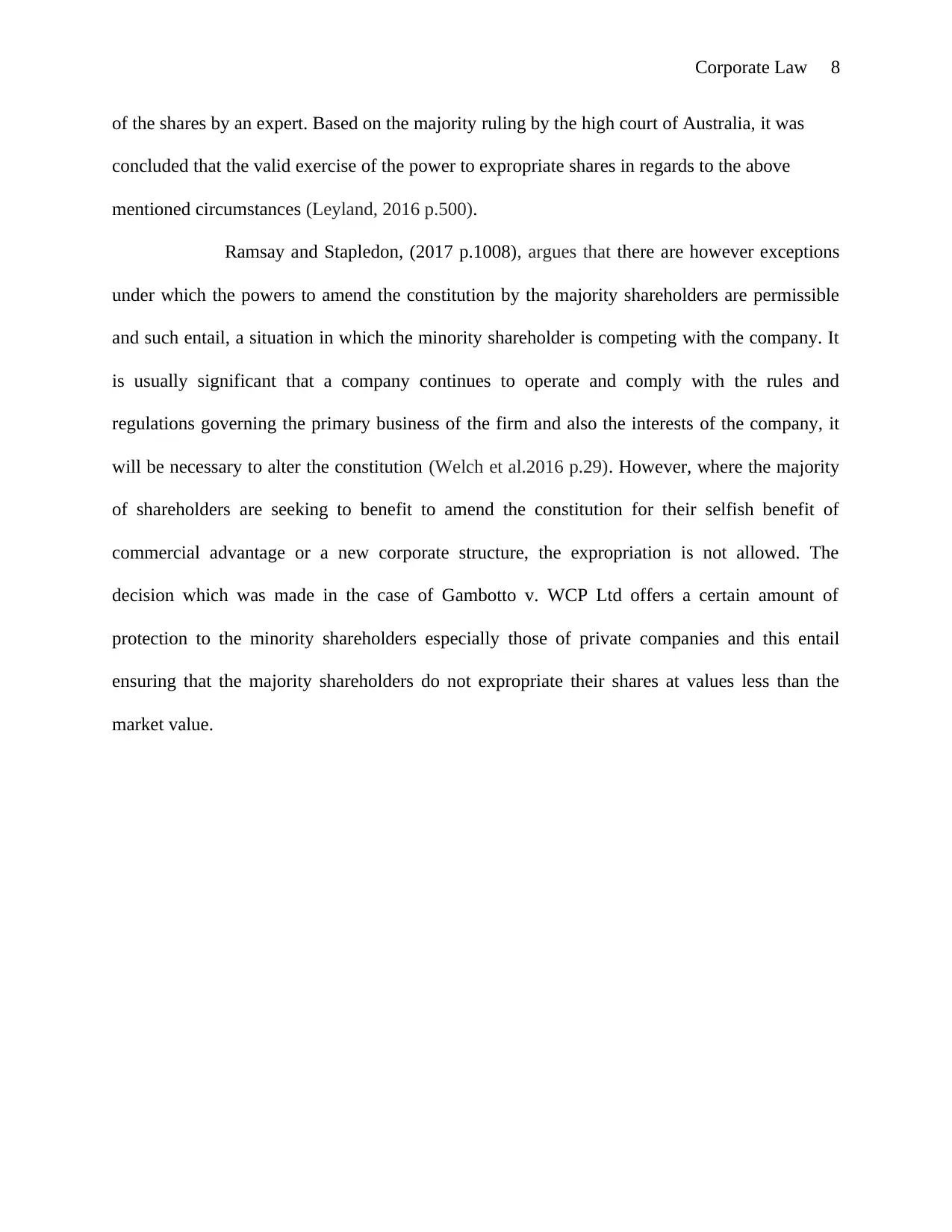
Corporate Law 8
of the shares by an expert. Based on the majority ruling by the high court of Australia, it was
concluded that the valid exercise of the power to expropriate shares in regards to the above
mentioned circumstances (Leyland, 2016 p.500).
Ramsay and Stapledon, (2017 p.1008), argues that there are however exceptions
under which the powers to amend the constitution by the majority shareholders are permissible
and such entail, a situation in which the minority shareholder is competing with the company. It
is usually significant that a company continues to operate and comply with the rules and
regulations governing the primary business of the firm and also the interests of the company, it
will be necessary to alter the constitution (Welch et al.2016 p.29). However, where the majority
of shareholders are seeking to benefit to amend the constitution for their selfish benefit of
commercial advantage or a new corporate structure, the expropriation is not allowed. The
decision which was made in the case of Gambotto v. WCP Ltd offers a certain amount of
protection to the minority shareholders especially those of private companies and this entail
ensuring that the majority shareholders do not expropriate their shares at values less than the
market value.
of the shares by an expert. Based on the majority ruling by the high court of Australia, it was
concluded that the valid exercise of the power to expropriate shares in regards to the above
mentioned circumstances (Leyland, 2016 p.500).
Ramsay and Stapledon, (2017 p.1008), argues that there are however exceptions
under which the powers to amend the constitution by the majority shareholders are permissible
and such entail, a situation in which the minority shareholder is competing with the company. It
is usually significant that a company continues to operate and comply with the rules and
regulations governing the primary business of the firm and also the interests of the company, it
will be necessary to alter the constitution (Welch et al.2016 p.29). However, where the majority
of shareholders are seeking to benefit to amend the constitution for their selfish benefit of
commercial advantage or a new corporate structure, the expropriation is not allowed. The
decision which was made in the case of Gambotto v. WCP Ltd offers a certain amount of
protection to the minority shareholders especially those of private companies and this entail
ensuring that the majority shareholders do not expropriate their shares at values less than the
market value.
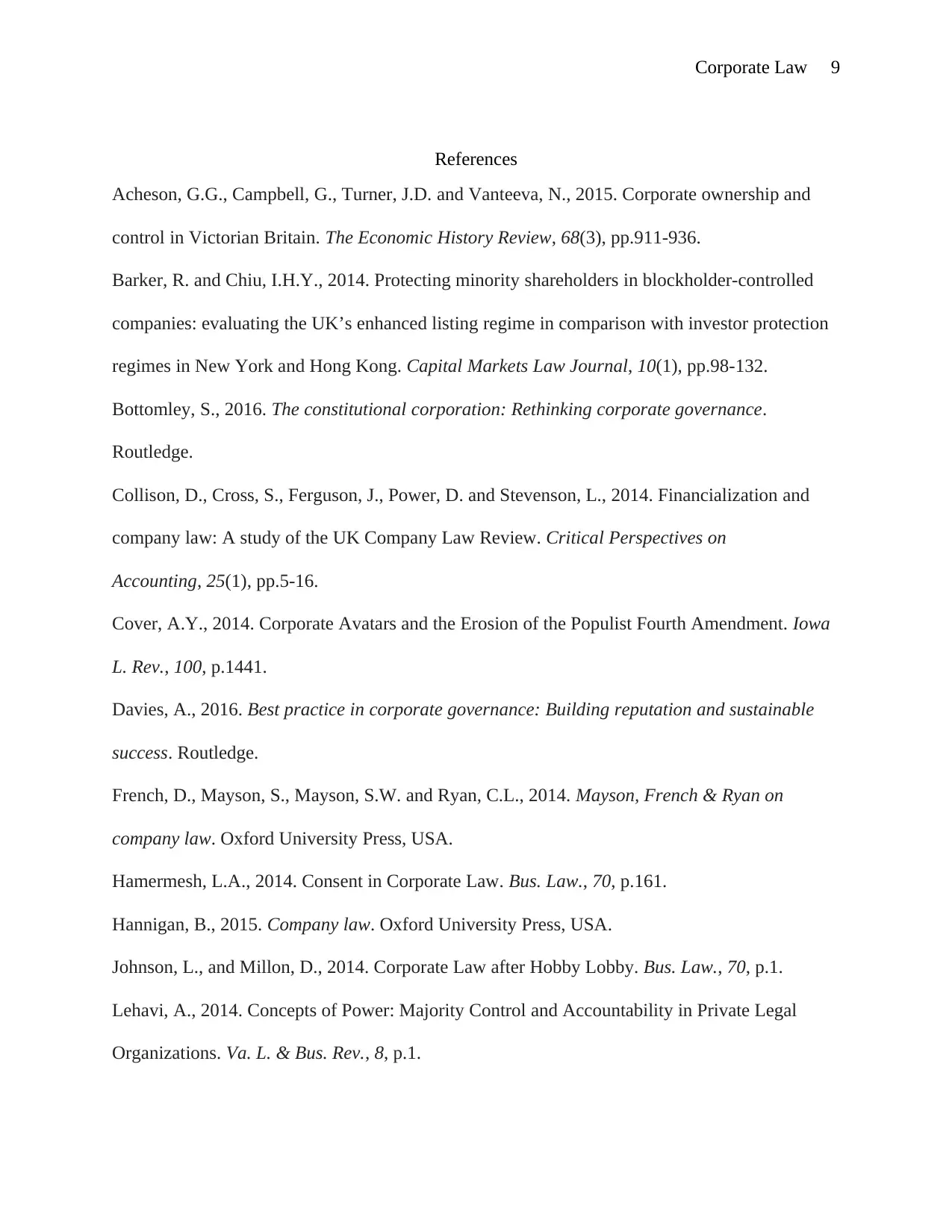
Corporate Law 9
References
Acheson, G.G., Campbell, G., Turner, J.D. and Vanteeva, N., 2015. Corporate ownership and
control in Victorian Britain. The Economic History Review, 68(3), pp.911-936.
Barker, R. and Chiu, I.H.Y., 2014. Protecting minority shareholders in blockholder-controlled
companies: evaluating the UK’s enhanced listing regime in comparison with investor protection
regimes in New York and Hong Kong. Capital Markets Law Journal, 10(1), pp.98-132.
Bottomley, S., 2016. The constitutional corporation: Rethinking corporate governance.
Routledge.
Collison, D., Cross, S., Ferguson, J., Power, D. and Stevenson, L., 2014. Financialization and
company law: A study of the UK Company Law Review. Critical Perspectives on
Accounting, 25(1), pp.5-16.
Cover, A.Y., 2014. Corporate Avatars and the Erosion of the Populist Fourth Amendment. Iowa
L. Rev., 100, p.1441.
Davies, A., 2016. Best practice in corporate governance: Building reputation and sustainable
success. Routledge.
French, D., Mayson, S., Mayson, S.W. and Ryan, C.L., 2014. Mayson, French & Ryan on
company law. Oxford University Press, USA.
Hamermesh, L.A., 2014. Consent in Corporate Law. Bus. Law., 70, p.161.
Hannigan, B., 2015. Company law. Oxford University Press, USA.
Johnson, L., and Millon, D., 2014. Corporate Law after Hobby Lobby. Bus. Law., 70, p.1.
Lehavi, A., 2014. Concepts of Power: Majority Control and Accountability in Private Legal
Organizations. Va. L. & Bus. Rev., 8, p.1.
References
Acheson, G.G., Campbell, G., Turner, J.D. and Vanteeva, N., 2015. Corporate ownership and
control in Victorian Britain. The Economic History Review, 68(3), pp.911-936.
Barker, R. and Chiu, I.H.Y., 2014. Protecting minority shareholders in blockholder-controlled
companies: evaluating the UK’s enhanced listing regime in comparison with investor protection
regimes in New York and Hong Kong. Capital Markets Law Journal, 10(1), pp.98-132.
Bottomley, S., 2016. The constitutional corporation: Rethinking corporate governance.
Routledge.
Collison, D., Cross, S., Ferguson, J., Power, D. and Stevenson, L., 2014. Financialization and
company law: A study of the UK Company Law Review. Critical Perspectives on
Accounting, 25(1), pp.5-16.
Cover, A.Y., 2014. Corporate Avatars and the Erosion of the Populist Fourth Amendment. Iowa
L. Rev., 100, p.1441.
Davies, A., 2016. Best practice in corporate governance: Building reputation and sustainable
success. Routledge.
French, D., Mayson, S., Mayson, S.W. and Ryan, C.L., 2014. Mayson, French & Ryan on
company law. Oxford University Press, USA.
Hamermesh, L.A., 2014. Consent in Corporate Law. Bus. Law., 70, p.161.
Hannigan, B., 2015. Company law. Oxford University Press, USA.
Johnson, L., and Millon, D., 2014. Corporate Law after Hobby Lobby. Bus. Law., 70, p.1.
Lehavi, A., 2014. Concepts of Power: Majority Control and Accountability in Private Legal
Organizations. Va. L. & Bus. Rev., 8, p.1.
⊘ This is a preview!⊘
Do you want full access?
Subscribe today to unlock all pages.

Trusted by 1+ million students worldwide
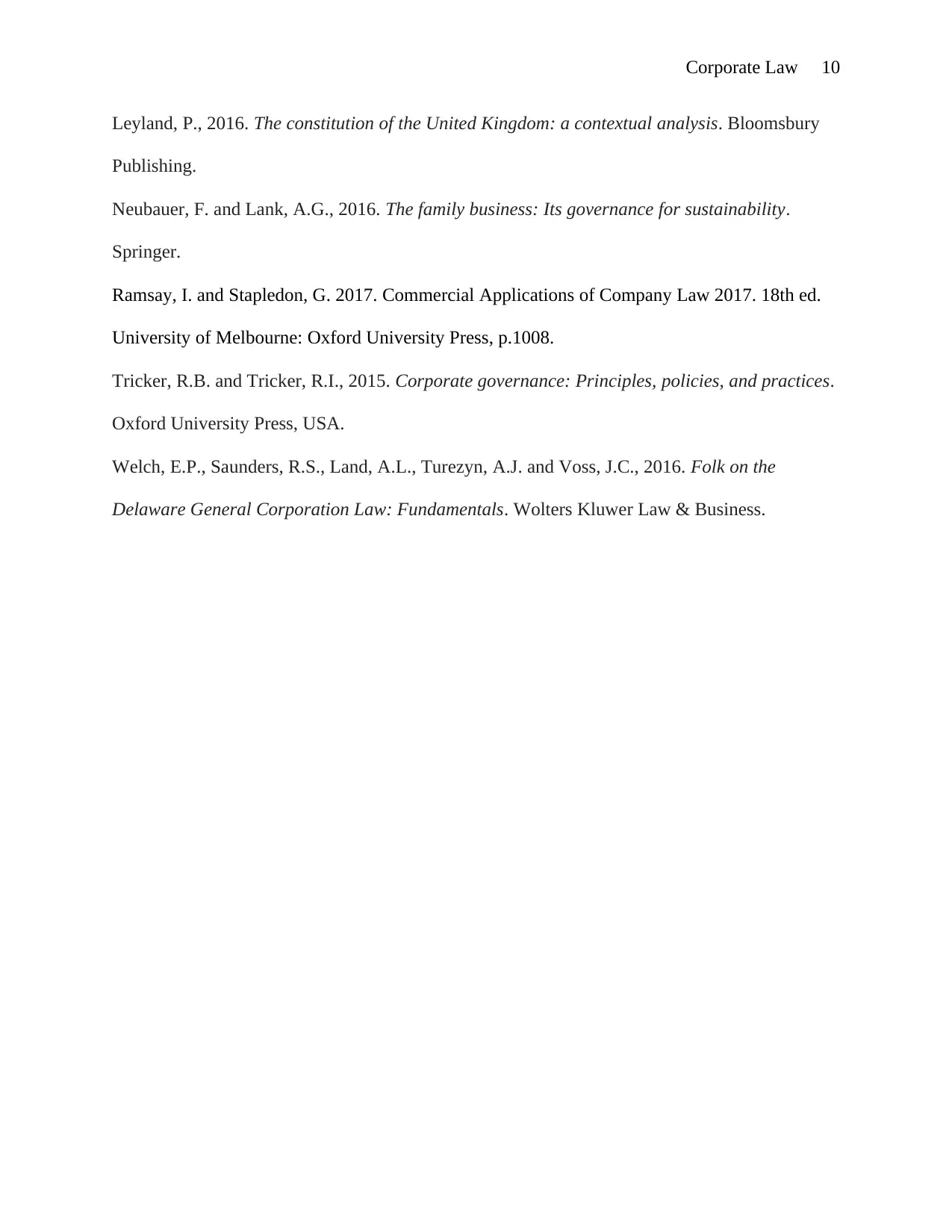
Corporate Law 10
Leyland, P., 2016. The constitution of the United Kingdom: a contextual analysis. Bloomsbury
Publishing.
Neubauer, F. and Lank, A.G., 2016. The family business: Its governance for sustainability.
Springer.
Ramsay, I. and Stapledon, G. 2017. Commercial Applications of Company Law 2017. 18th ed.
University of Melbourne: Oxford University Press, p.1008.
Tricker, R.B. and Tricker, R.I., 2015. Corporate governance: Principles, policies, and practices.
Oxford University Press, USA.
Welch, E.P., Saunders, R.S., Land, A.L., Turezyn, A.J. and Voss, J.C., 2016. Folk on the
Delaware General Corporation Law: Fundamentals. Wolters Kluwer Law & Business.
Leyland, P., 2016. The constitution of the United Kingdom: a contextual analysis. Bloomsbury
Publishing.
Neubauer, F. and Lank, A.G., 2016. The family business: Its governance for sustainability.
Springer.
Ramsay, I. and Stapledon, G. 2017. Commercial Applications of Company Law 2017. 18th ed.
University of Melbourne: Oxford University Press, p.1008.
Tricker, R.B. and Tricker, R.I., 2015. Corporate governance: Principles, policies, and practices.
Oxford University Press, USA.
Welch, E.P., Saunders, R.S., Land, A.L., Turezyn, A.J. and Voss, J.C., 2016. Folk on the
Delaware General Corporation Law: Fundamentals. Wolters Kluwer Law & Business.
1 out of 10
Related Documents
Your All-in-One AI-Powered Toolkit for Academic Success.
+13062052269
info@desklib.com
Available 24*7 on WhatsApp / Email
![[object Object]](/_next/static/media/star-bottom.7253800d.svg)
Unlock your academic potential
Copyright © 2020–2025 A2Z Services. All Rights Reserved. Developed and managed by ZUCOL.





